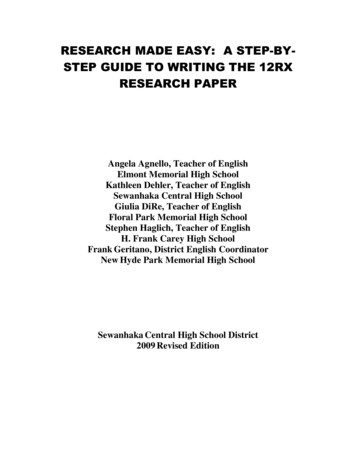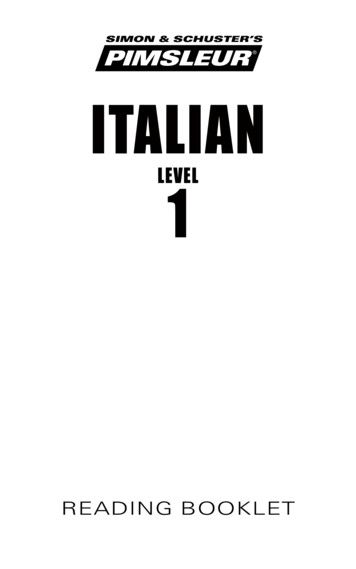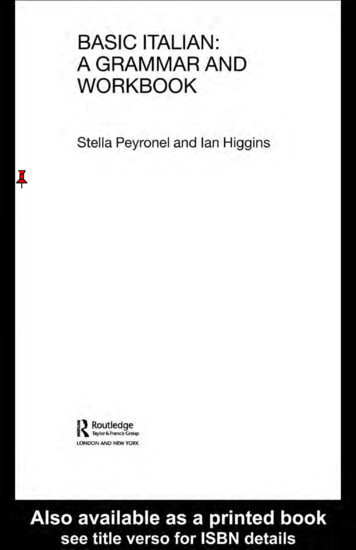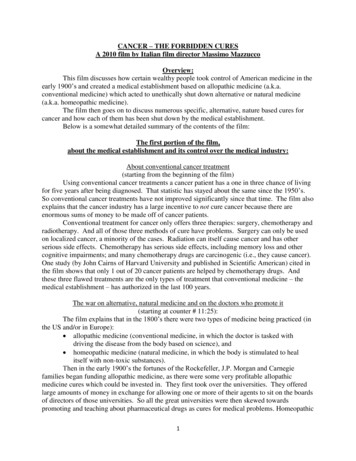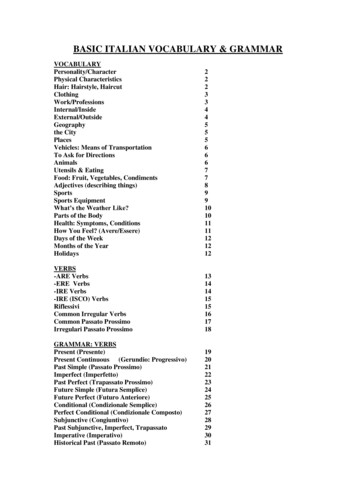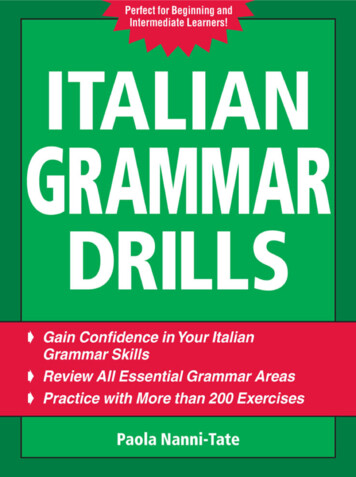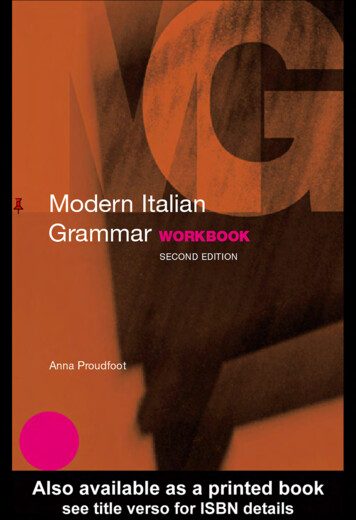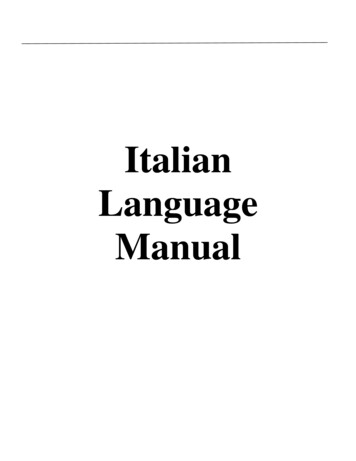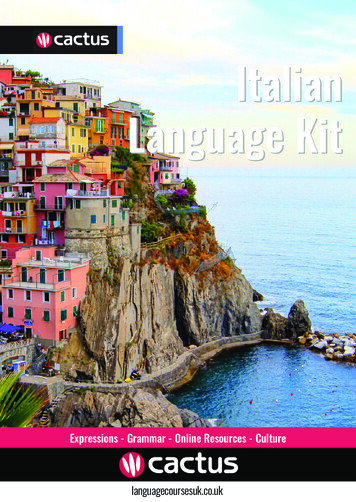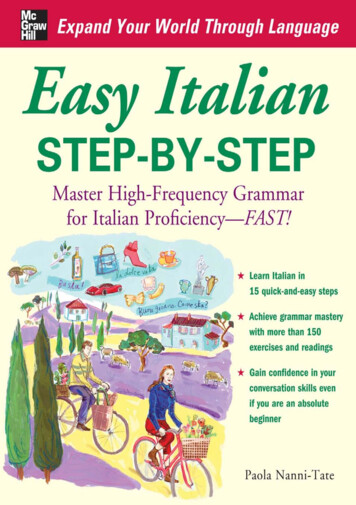
Transcription
Easy ItalianSTEP-BY-STEPMaster High-Frequency Grammarfor Italian Proficiency—FAST!Paola Nanni-TateNew York Chicago San Francisco Lisbon London Madrid Mexico CityMilan New Delhi San Juan Seoul Singapore Sydney Toronto
Copyright 2009 by The McGraw-Hill Companies, Inc. All rights reserved. Except as permitted under the United StatesCopyright Act of 1976, no part of this publication may be reproduced or distributed in any form or by any means, or storedin a database or retrieval system, without the prior written permission of the publisher.ISBN: 978-0-07-164222-4MHID: 0-07-164222-6The material in this eBook also appears in the print version of this title: ISBN: 978-0-07-145389-9, MHID: 0-07-145389-X.All trademarks are trademarks of their respective owners. Rather than put a trademark symbol after every occurrence ofa trademarked name, we use names in an editorial fashion only, and to the benefit of the trademark owner, with no intention of infringement of the trademark. Where such designations appear in this book, they have been printed with initialcaps.McGraw-Hill eBooks are available at special quantity discounts to use as premiums and sales promotions, or for use incorporate training programs. To contact a representative please visit the Contact Us page at www.mhprofessional.com.TERMS OF USEThis is a copyrighted work and The McGraw-Hill Companies, Inc. (“McGraw-Hill”) and its licensors reserve all rightsin and to the work. Use of this work is subject to these terms. Except as permitted under the Copyright Act of 1976 andthe right to store and retrieve one copy of the work, you may not decompile, disassemble, reverse engineer, reproduce,modify, create derivative works based upon, transmit, distribute, disseminate, sell, publish or sublicense the work or anypart of it without McGraw-Hill’s prior consent. You may use the work for your own noncommercial and personal use; anyother use of the work is strictly prohibited. Your right to use the work may be terminated if you fail to comply with theseterms.THE WORK IS PROVIDED “AS IS.” McGRAW-HILL AND ITS LICENSORS MAKE NO GUARANTEES OR WARRANTIES AS TO THE ACCURACY, ADEQUACY OR COMPLETENESS OF OR RESULTS TO BE OBTAINEDFROM USING THE WORK, INCLUDING ANY INFORMATION THAT CAN BE ACCESSED THROUGH THEWORK VIA HYPERLINK OR OTHERWISE, AND EXPRESSLY DISCLAIM ANY WARRANTY, EXPRESS ORIMPLIED, INCLUDING BUT NOT LIMITED TO IMPLIED WARRANTIES OF MERCHANTABILITY OR FITNESSFOR A PARTICULAR PURPOSE. McGraw-Hill and its licensors do not warrant or guarantee that the functions contained in the work will meet your requirements or that its operation will be uninterrupted or error free. Neither McGrawHill nor its licensors shall be liable to you or anyone else for any inaccuracy, error or omission, regardless of cause, inthe work or for any damages resulting therefrom. McGraw-Hill has no responsibility for the content of any informationaccessed through the work. Under no circumstances shall McGraw-Hill and/or its licensors be liable for any indirect, incidental, special, punitive, consequential or similar damages that result from the use of or inability to use the work, even ifany of them has been advised of the possibility of such damages. This limitation of liability shall apply to any claim orcause whatsoever whether such claim or cause arises in contract, tort or otherwise.
ContentsPrefacexiGuide to PronunciationIxiiiElements of a Sentence1 Nouns, Articles, and Descriptive AdjectivesThe Gender of Nouns 3Singular Nouns 3Plural Nouns 6The Indefinite Article 9The Definite Article 11Other Uses of the Definite ArticleDescriptive Adjectives 17Singular Form of Adjectives 17Key Vocabulary 18Colori (Colors) 18Aggettivi (Adjectives) 18Plural Form of Adjectives 19Positioning of Adjectives 21132 Subject Pronouns, stare, and essereSubject Pronoun Basics 25Stare Versus essere 26Stare (to be; to stay) 26Key Vocabulary 28Parole interrogative (Interrogative Words) 28Avverbi di luogo (Adverbs of Location) 28Aggettivi (Adjectives) 28Essere (to be) 29Reading Comprehension La casa 35iii253
ivContents3 C ’è and ci sono, Interrogative Words,and the Calendar 38C’è (There Is) and ci sono (There Are) 38Ecco 39Interrogative Words 42Prepositions 46Calendario (Calendar) 47I giorni della settimana (Days of the Week) 47I mesi dell’anno (Months of the Year) 47Le stagioni (Seasons) 48Le parti del giorno (Parts of the Day) 48Reading Comprehension Una città italiana 51Key Vocabulary 53Nomi maschili (Masculine Nouns) 53Nomi femminili (Feminine Nouns) 53Aggettivi (Adjectives) 53Reading Comprehension Il cinema 564 Numbers, Time, and DatesCardinal Numbers 58Ordinal Numbers 61Special Uses of Ordinal Numbers 64The Date 65Telling Time 66Reading Comprehension Il ristorante 70Reading Comprehension Il lavoro casalingo5 Regular Verbs587174Uses of the Present Tense 74Asking Questions 74Negative Statements 75Using the Present to Express the Future 75-are Verbs 75Frequently Used -are Verbs 76The Preposition a 77-ere Verbs 78Frequently Used -ere Verbs 79-ire Verbs 80Frequently Used -ire Verbs 81Frequently Used -isc- Verbs 83-are and -ere Verbs with More than One Meaning 84Reading Comprehension Arturo e Carla 86
vContents6 Irregular Verbs88Irregular -are Verbs 88Fare (to do; to make) 89Stem Changes 91-ere Verbs 93Sentence Formation 93To Know: conoscere Versus sapere 94Avere (to have) 96-ire Verbs 99Apparire (to appear) 100Reading Comprehension La famiglia Marchetti7 Andare and the Future102104Andare (to go; to be going) 104The Future with andare a Infinitive 105The Future Tense of Regular Verbs 106Stem Changes in the Future Tense 107The Future Tense of Irregular Verbs 108Key Vocabulary 111-are Verbs 111Useful Words: che and per 112The Relative Pronoun che 112The Conjunction che 112The Preposition per 112Key Vocabulary 113Parti del corpo (Parts of the Body) 113Dentro al corpo (Inside the Body) 114La famiglia (The Family) 115Time Expressions 115Reading Comprehension L’appuntamento dal dentista8 Adjectives and Adverbs121Possessive Adjectives 121Definite Articles 123Demonstrative Adjectives 126Adjectives of Nationality 128Adjectives That Precede a Noun 130The Adjective bello 131Adjectives That Express Quantity 132Adjectives That Express Next, Only, and Last 133Comparative Adjectives 134More . . . than, or Comparative of Majority 134Less . . . than, or Comparative of Minority 135As . . . as, or Comparative of Equality 135119
viContentsSuperlative Adjectives 137Irregular Comparatives and Superlatives 138Adverbs 140Adverbs of Time 143Adverbs of Location 144Reading Comprehension Il cane e il gatto 1479 Negatives and Prepositions150Negatives and Negative Expressions 150More Negative Expressions 152Prepositions 154Prepositions Followed by Verbs or Nouns 155Prepositions Followed by Nouns or Pronouns 155Prepositions Followed by Pronouns 156The Many Meanings of the Preposition per 157Reading Comprehension Il treno 161Key Vocabulary 164Natura (Nature) 164Tempo (Weather) 164Reading Comprehension La visita 170IIObjects, Reflexive Verbs, and the PresentSubjunctive10 The Indirect Object174Piacere and the Indirect Object 174Mi piace and mi piacciono 174Ti piace and ti piacciono 176Le piace and le piacciono 177Gli piace and gli piacciono 177Ci piace and ci piacciono 178Vi piace and vi piacciono 178A loro piace and a loro piacciono 178Verbs like piacere 180Indirect Object Pronouns 185Position of the Indirect Object Pronoun 187Reading Comprehension Andare a fare spese 195Reading Comprehension La spiaggia 196
viiContents11 The Direct Object199Transitive Verbs and the Direct Object 199Direct Object Pronouns 201Position of the Direct Object Pronoun 202The Direct Object Pronoun as a Person 203The Direct Object Pronoun as a Thing 205Review Table of Indirect and Direct Object Pronouns 206Reading Comprehension Gli svaghi degli italiani 20912 Reflexive Verbs211Reflexive Pronouns 211Frequently Used Reflexive Verbs 212Reflexive Verbs Whose English Translations Do Not Include Oneself 212Position of the Reflexive Pronoun 213Reflexive Verbs with Parts of the Body and Clothing 214Reflexive Verbs That Express Emotion or Movement 215Reflexive Verbs Followed by a Preposition 216Review of Indirect and Direct Object Pronouns and Reflexive Pronouns 217Reflexive Verbs with Reciprocal Meanings 218Si and Impersonal Expressions 218Reading Comprehension Il saluto e l’educazione 219Reading Comprehension I mezzi di trasporto pubblici 22113 The Present Subjunctive223Formation of the Present Subjunctive 223-are Verbs 224-ere and -ire Verbs 225Irregular Verbs 227Verbs with Orthographic Changes 227Uses of the Present Subjunctive 228After Certain Impersonal Expressions 228After Certain Verbs 230After Certain Conjunctions 236In Certain Dependent Adjective Clauses 237After the Expression per quanto 238After benché 238After Compounds of -unque 238Reading Comprehension Lo sport in Italia 244
viiiIIIContentsThe Preterit, Present Perfect, andImperfect Tenses and Double ObjectPronouns14 The Preterit and the Present Perfect TensesFormation of the Preterit 248Regular -are Verbs 249Regular -ere Verbs 249Regular -ire Verbs 250Key Vocabulary 250Expressions Often Used with the Preterit 250Uses of the Preterit 251To Express an Action Completed in the Past 251To Express a Series of Completed Actions in the Past 252To Express an Action That Is No Longer in Effect 252Irregular Verbs 253The Present Perfect Tense 259Formation of the Present Perfect 259Present Perfect with avere 259Verbs with Irregular Past Participles 260Past Participle Agreement of Verbs Conjugatedwith avere in the Present Perfect 262Present Perfect with essere 263Verbs Conjugated with essere in the Present Perfect 264Additional Rules for Using essere in the Present Perfect 265Reading Comprehension La moda italiana 26715 The Imperfect Tense270Formation of the Imperfect 270Regular -are Verbs 270Regular -ere Verbs 271Regular -ire Verbs 272Irregular Verbs 272Uses of the Imperfect 274To Express a Narration, a Situation, or a Background in the Past 274To Express Repeated, Habitual Actions in the Past 274To Express a Description in the Past 275To Express a Continuous Action in the Past 275To Express Age, Time of Day, and Weather in the Past 275To Express Size, Color, and Personal Qualities in the Past 275To Express an Ongoing Action in the Past with the Preposition da 276248
ContentsPreterit, Present Perfect, and Imperfect Compared 277Volere, potere, sapere 278Double Object Pronouns 283Me lo, me la, me li, me le 283Te lo, te la, te li, te le 285Glielo, gliela, glieli, gliele 286Ce lo, ce la, ce li, ce le 288Ve lo, ve la, ve li, ve le 289Reflexive Pronouns with Direct Object Pronouns 291Reading Comprehension Il traffico in Italia 294Answer KeyIndex313297ix
This page intentionally left blank
PrefaceEasy Italian Step-by-Step will help you learn Italian in a short time. Written for beginner and advanced-beginner learners, it teaches grammar in alogical order that enables you to develop your language skills and the abilityto converse, read, and write in a very natural way.I advise you to study each chapter, or step, without skipping from one toanother, in order to take advantage of the grammatical progression plannedwith you in mind. Study each chapter, and be sure you know and understandevery grammatical concept before proceeding to the next. Each step willlead you to the next chapter. You have to know one in order to be able tostudy the next.Try to learn the vocabulary and the verbs provided. They have been carefully selected on the basis of usefulness and frequent use. The vocabularylists will help you enhance your ability to communicate, while complete verbconjugations are given so that you can practice the pronunciation as youlearn the verbs. More than three hundred of the most common Italian verbsare presented.Multiple and varied written exercises are included to test your progressin learning the language. The book has a complete answer key to help youcheck your accuracy. It is a good idea to write down your own sentences andpractice them aloud. Feel free to do this as often as you please. The moreyou do it, the easier it becomes.Original readings are included at the end of each chapter. They are progressively more complex in form and content. Use these reading comprehension selections to learn new vocabulary, and practice reading aloud tobecome familiar with the pronunciation.Easy Italian Step-by-Step is divided into three parts. The first part givesyou the basic language in the present tense. Because the word order in Italian and English in this part is basically the same, learning in the early stagesxi
xiiPrefaceis very quick. The second part explains the indirect object, direct object, reflexive verbs, and present subjunctive. The third part presents the most usedtenses in the past: the preterit, the present perfect, and the imperfect.Italian is a phonetic language. Once you learn to pronounce each voweland consonant, you will be able to pronounce all words correctly. In thissense, Italian is easy to learn, but the grammatical rules are complex and numerous and need to be studied. If you learn these rules a few at a time, stepby-step, it will be easier to master the language. Before you begin, practiceall the sounds outlined in the “Guide to Pronunciation” section in the following pages. Don’t neglect the exercises, and make sure to read and answerthe questions aloud as often as possible in order to develop confidence inyour pronunciation and ability to speak.This book will help you learn Italian whether you are a self-study learneror a student in a regular class. With Easy Italian Step-by-Step, you will beable to read and write Italian quite well. The grammar is standard to allparts of Italy, and even if the accents change from region to region, you willget used to them, and you will be able to understand and speak to everybody. Have fun and try to use what you have learned. Italians will appreciateyour efforts and w
01.12.2017 · Easy Italian Step-by-Step will help you learn Italian in a short time. Writ-ten for beginner and advanced-beginner learners, it teaches grammar in a logical order that enables you to develop your language skills and the ability to converse, read, and write in a very natural way.
